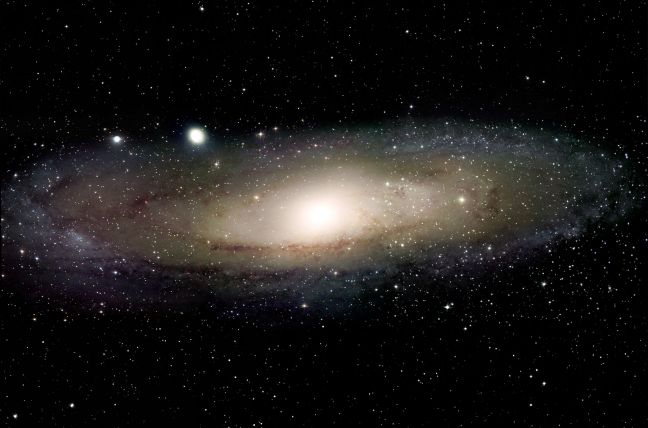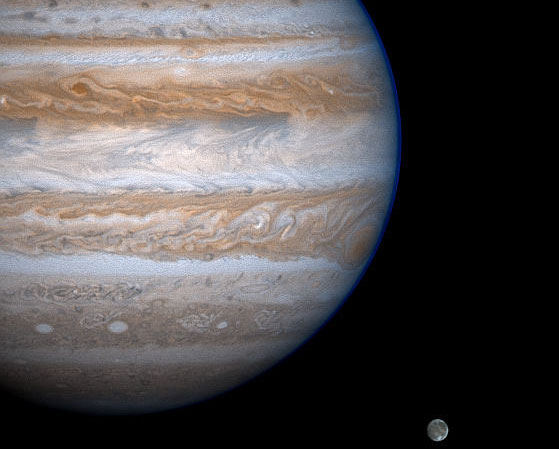Galaxies, Planets & Nebulae
Most pics courtesy of NASA
Andromeda Island Universe


Explanation: How far can you see? The most distant object visible to the unaided eye is M31, the great Andromeda Galaxy some two million light-years away. Without a telescope, even this immense spiral galaxy appears as an unremarkable, faint, nebulous cloud in the constellation Andromeda. But a bright yellow nucleus, dark winding dustlanes, gorgeous blue spiral arms and star clusters are recorded in this stunning telescopic digital mosaic of the nearby island universe. While even casual skygazers are now inspired by the knowledge that there are many distant galaxies like M31, astronomers seriously debated this fundamental concept only 80 years ago. Were these "spiral nebulae" simply outlying components of our own Milky Way Galaxy or were they instead "island universes" -- distant systems of stars comparable to the Milky Way itself? This question was a central to the famous Shapley-Curtis debate of 1920 which was later resolved by observations of M31 in favor of Andromeda, island universe.

Explanation: What is creating the strange texture of IC 418? Dubbed the Spirograph Nebula for its resemblance to drawings from a cyclical drawing tool, the patterns of planetary nebula IC 418 are not well understood. Perhaps they are related to chaotic winds from the variable central star, which changes brightness unpredictably in just a few hours. By contrast, evidence indicates that only a few million years ago, IC 418 was probably a well-understood star similar to our Sun. Only a few thousand years ago, IC 418 was probably a common red giant star. Since running out of nuclear fuel, though, the outer envelope has begun expanding outward leaving a hot remnant core destined to become a white-dwarf star, visible in the image center. The light from the central core excites surrounding atoms in the nebula causing them to glow. IC 418 lies about 2000 light-years away and spans 0.3 light-years across. This recently released false-color image taken from the Hubble Space Telescope reveals the unusual details.

Explanation: In the depths of the dark clouds of dust and molecular gas known as M17, stars continue to form. Visible in the above recently released representative-color photograph of M17 by the New Technology Telescope are clouds so dark that they appear almost empty of near infrared light. The darkness of these molecular clouds results from background starlight being absorbed by thick carbon-based smoke-sized dust. As bright massive stars form, they produce intense and energetic light that slowly boils away the dark shroud. M17's unusual appearance has garnered it such nicknames as the Omega Nebula, the Horseshoe Nebula, and the Swan Nebula. M17, visible with binoculars towards the constellation of Sagittarius, lies 5000 light-years away and spans 20 light-years across.

Explanation: A new spacecraft has entered the outer Solar System: Cassini. Launched in 1997 and bound for Saturn in 2004, Cassini sent back the above image last week while approaching the giant planet Jupiter. Cassini joins the Galileo spacecraft currently in orbit around Jupiter in studying the gas giant and its moons. In fact, observations involving both spacecraft simultaneously are planned in the coming months. This color picture was taken when Cassini was 81.3 million kilometers from Jupiter. The alternating dark and bright bands characteristic of Jupiter's cloud tops can be easily seen. Jupiter's moon Europa is also seen at the far right of the image, casting a round shadow on the planet.


Explanation: Who keeps an eye on the largest moon in the Solar System? This moon, visible on the lower right, is Ganymede, and the planet it orbits, Jupiter, seems to be keeping a watchful eye, as its Great Red Spot appears serendipitously nearby. This recently released enhanced-contrast image from the robot spacecraft Cassini captures new details of the incredible intricacies of Jupiter's complex cloud patterns. Features as small as 250 kilometers can be seen. Large dark plume clouds are visible in Jupiter's central white band that did not exist when Voyager spacecraft passed the planet twenty years ago. Counter-clockwise rotating high-pressure white ovals that are similar to the Great Red Spot appear in the red band below the spot. Between these spots are darker low-pressure systems that rotate clockwise. The hydrogen and helium that compose most of Jupiter's clouds is nearly invisible - the trace chemicals that give Jupiter these colors remain unknown. The Cassini spacecraft is using Jupiter to pull it toward Saturn, where it is scheduled to arrive in 2004.

Explanation: The Plane of the Ecliptic is well illustrated in this picture from the 1994 lunar prospecting Clementine spacecraft. Clementine's star tracker camera image reveals (from right to left) the Moon lit by Earthshine, the Sun's corona rising over the Moon's dark limb, and the planets Saturn, Mars, and Mercury. The ecliptic plane is defined as the imaginary plane containing the Earth's orbit around the Sun. In the course of a year, the Sun's apparent path through the sky lies in this plane. The Solar System's planetary bodies all tend to lie near this plane, since they were formed from the Sun's spinning, flattened, proto-planetary disk. The snapshot above nicely captures a momentary line-up looking out along this fundamental plane of our Solar System.

Explanation: Amazingly detailed, this false-color x-ray image is centered on the galaxy Cygnus A. Recorded by the orbiting Chandra Observatory, Cygnus A is seen here as a spectacular high energy x-ray source. But it is actually more famous at the low energy end of the electromagnetic spectrum as one of the brightest celestial radio sources. Merely 700 million light-years distant, Cygnus A is the closest powerful radio galaxy and the false-color radio image (inset right) shows remarkable similarity to Chandra's x-ray view. Central in both pictures, the center of Cygnus A shines brightly while emission extends 300,000 light-years to either side along the same axis. Near light speed jets of atomic particles produced by a massive central black hole are believed to cause the emission. In fact, the x-ray image reveals "hot spots" suggestive of the locations where the particle jets are stopped in surrounding cooler, denser gas. The x-ray image also shows that the jets have cleared out a huge cavity in the surrounding gas. Bright swaths of emission within the cavity likely indicate x-ray hot material ... swirling toward the central black hole.
|